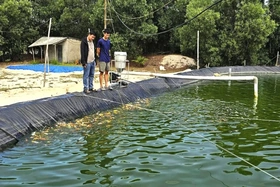{title}
{publish}
{head}
The central province of Quang Tri has integrated goals on green growth in its annual and five-year socio-economic development plans to implement the National Strategies and Action Plan on Green Growth for 2021-2030.
Accordingly, Quang Tri is actively reshaping its economic structure with a shift toward a more sustainable growth model, prioritizing reductions in greenhouse gas emissions through strategic energy resource utilization, focusing on renewables.

Rooftop solar is a new energy source contributing to Quang Tri’s green growth targets. Photo: T.N
By the end of 2024, the province boasted 20 wind farms, three solar power stations, 10 hydroelectric plants, and 151 rooftop solar systems, collectively generating 1,119.5 MW of commercial electricity, more than 2.5 times the output recorded in 2020. The majority of this capacity originates from renewable sources.
In addition, the province has approved 11 additional wind energy projects with 424 MW, seven hydro projects with 93 MW, one coal-fired power plant with 1,320 MW, and two gas-fired power ventures totaling 1,840 MW. They are progressing through investment and construction phases.
These moves show Quang Tri’s strategic commitment to renewable energy, contributing substantively to Vietnam’s net-zero goal by 2050. The province’s key goals include harmonizing energy sector growth with integrated infrastructure, ensuring equitable energy transition, and upholding national energy security.
At the same time, the province is advancing programs that support renewable energy industries, develop carbon capture and utilization technologies, and catalyze the production of green hydrogen and green ammonia. Meanwhile, it is encouraging energy efficiency and promoting a shift toward clean energy across all economic sectors, including industry, agriculture, services, commerce, and residential use.
Among renewable sources, biomass and waste-to-energy projects are being actively promoted to leverage agricultural and forestry by-products and wood processing residues. The models have contributed to environmental protection and reforestation efforts while aligning with the development of a renewable energy credit market.
To promote clean electricity, the province has allowed unrestricted expansion of rooftop solar systems on public buildings and private residences under a decentralized, self-generation, and self-consumption model.
Strategic vision for green hydrogen
Acting Chairman of the Quang Tri People’s Committee, Ha Sy Dong, said that the global green hydrogen industry is expected to accelerate rapidly post-2025. In anticipation, Quang Tri has incorporated green fuel development into the province’s 2021–2030 plan, with a vision to 2050. The province is currently identifying investment sites and facilitating large-scale projects aimed at producing green hydrogen and ammonia with targeted annual outputs exceeding 120,000 tons.
Quang Tri has also received a formal proposal from O-Door Engineering and Construction Co., Ltd., and its international partners to establish a High-tech Research and Training Center for Renewable Energy, with a focus on green hydrogen, within the province.
Following comprehensive site surveys, the joint venture has requested provincial approval to pursue an energy transition investment initiative on a designated land area within the Southeast Quang Tri Economic Zone.
There should be a Hi-tech Research and Training Center on renewable energy and human resources to operate, monitor, and maintain energy projects in and outside the province. The center is believed to be good for the locality’s green development agenda. Quang Tri’s leadership has pledged full support to expedite the initiative, ensuring alignment with local geographic conditions, available resources, and the scientific and practical potential of the coastal zone.
Addressing infrastructure and grid challenges
The expansion of renewable energy has delivered multiple benefits, including jobs, improved livelihoods, and enhanced fiscal contributions. It’s also the rapid proliferation of high-capacity projects that has led to grid congestion and stability risks.
These challenges require the urgent need to upgrade and expand infrastructure for power generation, transmission, storage, distribution, and grid management, which is capable of accommodating large-scale renewable energy integration.
In this context, the Quang Tri 500 kV Substation and the Quang Tri-Vung Ang-Danang transmission line have emerged as critical infrastructure projects. Designed to alleviate grid bottlenecks and transmit renewable energy from Quang Tri and neighboring provinces to the national grid, these projects are expected to boost transmission capacity by approximately 900 MVA.
Once operational, the Quang Tri 500 kV Substation will significantly reduce energy loss and ensure a stable power supply for the region. It will also serve as a vital node in the broader national grid, enabling the efficient commercialization of renewable power.
Additionally, the province has approved investment policies and selected developers for the Lao Bao 500 kV Substation in Huong Hoa District and its 220 kV connection line, along with the Quang Tri 2,500 kV Switching Station and its associated transmission routes.
These projects have experienced several steps, with the completion of geological and topographic surveys. The Vietnam Electricity (EVN) is currently expediting feasibility studies and technical consultations to facilitate swift implementation.
These investments are poised to ease transmission pressures, enhance renewable energy uptake, and accelerate Quang Tri’s transition to a green, resilient, and sustainable energy future.
Tan Nguyen – Linh Pham

QTO - In Quang Tri, clean agricultural stores may not flaunt flashy signs or wide storefronts, but they are quietly becoming trusted places where consumers...

QTO - In a quiet village in central Vietnam, Le Minh Duc, 26, has turned his passion for ornamental fish into a promising startup, the first Koi breeding...